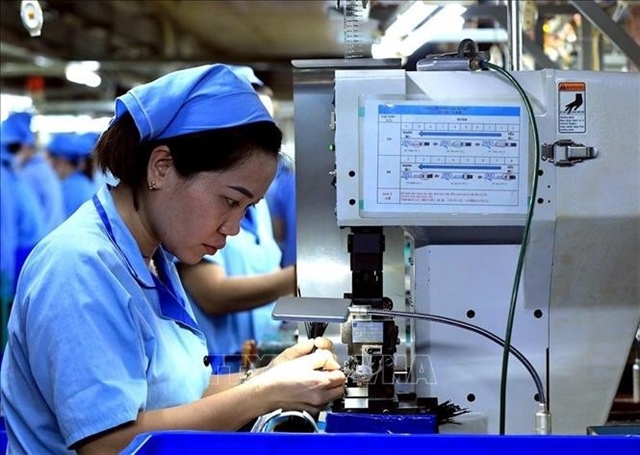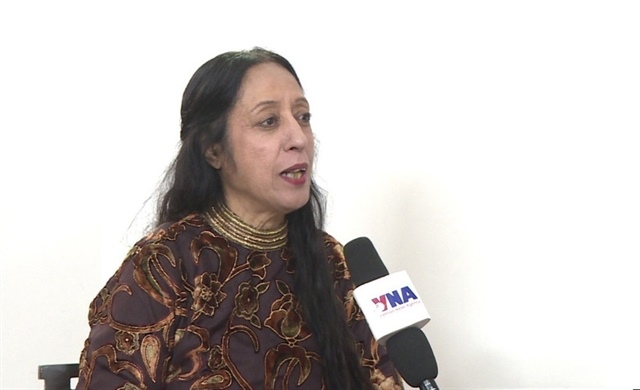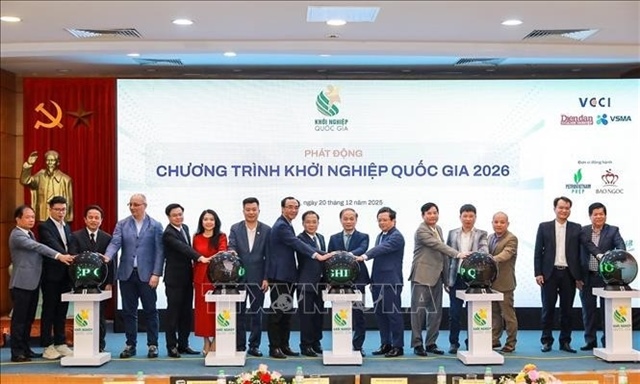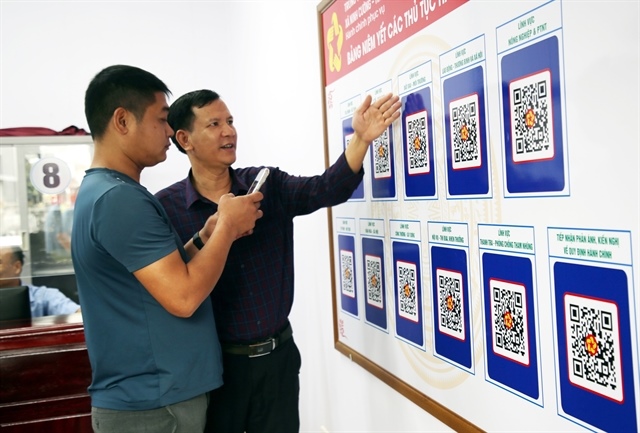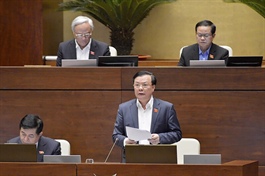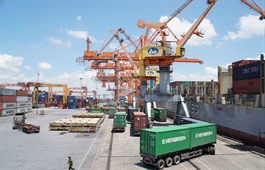Cautious action advised to secure sound economy
Cautious action advised to secure sound economy
The government is formulating its new economic growth goal for the next five years, amid its struggle against the health crisis and natural calamities undermining its efforts to reach targets. Questions are now being asked on how the country can effectively drive the economy forwards.
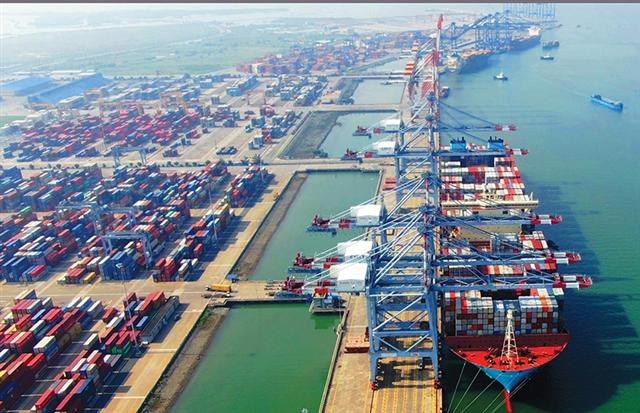
The World Bank forecasts that Vietnam’s GDP growth will reach 2.8 per cent in 2020 and rebound to 6.7 per cent in 2021, photo Le Toan
|
Though having yet to officially ask the National Assembly (NA) to revise down the economic growth rate for 2020 from the initial target of 6.8 per cent set late last year, the government has reported to the legislature that it expects the rate to be about 2-3 per cent this year due to the grave aftermath of the pandemic and natural calamities currently affecting the central region.
However, such a rate remains optimistic as Vietnam is forecast to be among countries with the highest growth in the region and the wider world thanks to its internal strength and ability in diversification and flexibility, according to the government and high-profile organisations such as the World Bank, Asian Development Bank (ADB), and global analysts FocusEconomics.
FocusEconomics last week told VIR in a statement that it predicts Vietnam’s annual GDP will rise on average from $240 billion during 2017-2019 to $295 billion in the 2020-2021 period, and to $379 billion during the 2023-2025 period.
The economy grew at a relatively high level, at 6.8 per cent annually, in the 2016-2019 period. However, if it grows 3 per cent this year, its 2016-2020 socioeconomic development plan will fail to reach its ambitious target of 6.5-7 per cent annually set one year ago.
At a recent meeting between the Ministry of Planning and Investment (MPI) with a working group of the NA, MPI Deputy Minister Tran Quoc Phuong said that the growth rate for the 2016-2020 period is estimated to be 5.8 per cent, but “still placing Vietnam in the group of nations with the highest growth in the world.”
Great caution
The government has proposed a plan to the NA on economic growth for 2021-2025, with an average annual rate of 6.5-7 per cent, and average capita income of $4,700-5,000. In 2021, the economy is planned to climb about 6 per cent.
However, the NA Economic Committee asked the government to “take great caution” to formulate the growth rate for the period due to numerous possible risks including COVID-19 and natural disasters which have become increasingly complicated.
“It is recommended that the government build up the growth target for the 2021-2025 period cautiously, with sufficient explanation and then submit it to the NA for official consideration and adoption,” said the committee’s Chairman Vu Hong Thanh.
NA Vice Chairman Phung Quoc Hien also said that it is necessary to carefully study and forecast the upcoming situation, both locally and internationally, when the government formulates the growth rate, which will influence the formulation of many other key goals such as employment, inflation, export-import, and investment.
For example, it is estimated that each percentage of growth can help generate about 500,000 direct jobs.
“In 2021, the situation is expected to continue being very difficult. The COVID-19 pandemic may not be radically quenched before June 2021, and the world at that time may not resume normality,” Hien said. “In 2021, the country may still have to both control the pandemic and recover the economy.”
“Thus, it will need great caution for the formulation of socioeconomic development goals including economic growth targets. It is likely that the 2021-2025 Socioeconomic Development Plan will have to be divided into two stages, with the first two years to be focused on economic recovery, and the remaining three years centred on boosting economic growth.”
It is expected that the domestic economy will continue facing numerous difficulties including a global economic downturn, especially in economies that are Vietnam’s key trade and investment partners, and the resurgence of COVID-19 continuing seriously sabotaging almost all sectors in the economy, especially tourism, transport, and export-import activities.
According to the International Monetary Fund (IMF), the pandemic is expected to drive many major economies to below-zero growth in 2020 and 2021. “This will negatively affect Vietnam’s economic growth in 2020 and beyond as Vietnam attracts a big volume of foreign direct investment (FDI) from them. They are also Vietnam’s big export markets,” said an expert from the Central Institute for Economic Management.
In Vietnam, FDI generated more than 20 per cent of economic growth by late last year.
The World Bank has meanwhile released a new forecast on Vietnam, stating that a new resilience development strategy is urgently needed, otherwise additional economic growth over the next decade in the range of billions of US dollars could be wiped away by natural shocks.
Achieving desired growth
According to Stefanie Stallmeister, acting country director for the World Bank in Vietnam, Vietnam should not envision a return to the old normal. Instead, it should define what will be the new normal as the pandemic has changed how people live, work, and communicate.
“Vietnam will operate in a world with a great deal of domestic and international uncertainty for the foreseeable future. Therefore, we believe that policymakers will have to compensate for the weakening of the country’s traditional drivers of growth, which have been foreign demand and local consumption,” she said.
However, the World Bank believed that Vietnam will continue to be one of the most dynamic economies in the world. Its latest forecast is that GDP growth will reach 2.8 per cent in 2020 and rebound to 6.7 per cent in 2021.
Meanwhile, the ADB also proposed that for Vietnam to reach higher growth, much remains to be done to overcome difficulties.
ADB country director for Vietnam Andrew Jeffries said, “Significant risks remain. A prolonged global COVID-19 pandemic remains the biggest risk to Vietnam’s growth outlook this year and next year. Another threat is global trade tensions, which lead to rising trade protection and financial risks that could be exacerbated by a prolonged pandemic.”
However, he also believed in a brighter outlook for the economy. “Vietnam is showing stronger resilience than most economies. Economic fundamentals have not been impaired, and Vietnam looks likely to benefit from current trends in global patterns of trade, investment, and production,” Jeffries said.
|
In order for Vietnam to ensured its desired economic growth until 2025, some tasks are proposed: - It is necessary to further institutional perfection and active participation into Industry 4.0, as well as digital transformation. Policies and laws for developing an e-government, heading towards a digital government must be accelerated. A more business-friendly and fairer climate needs to be created, with the creation of favourable policies for developing new business models applied with high technologies. - A legal framework on banking activities must be improved, with a boost in restructuring credit institutions and addressing bad debts. The stock market’s scale and effectiveness must also be increased. - It is needed to effectively tap into the domestic market and free trade agreements, and expand and diversify export markets, reducing negative impacts from trade conflicts on exports. Vietnamese goods’ prestige must be further enhanced. - Some fundamental industrial sectors must be developed, while connecting the processing and manufacturing industries with smart technologies. Local enterprises must be supported in forging links with foreign firms. It is necessary to attract investment and develop a modern large-scale agricultural sector, with the application of high and green technologies. - It is needed to effectively restructure public investment, with the state budget to be restructured sustainably. Loans are used for only development investment. State-owned enterprise reshuffling, equitisation, and divestment must be completed, with all poorly-performing enterprises to be radically solved. Notably, it is a must to create more favourable conditions for the private sector to flourish in scale and quality. - All resources must be focused on completing the eastern cluster of the North-South Expressway project and the first phase of the Long Thanh International Airport, and investing into planned key transportation projects. Source: National Assembly Economic Committee |


